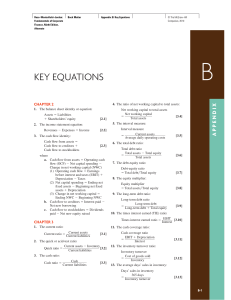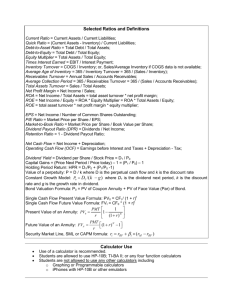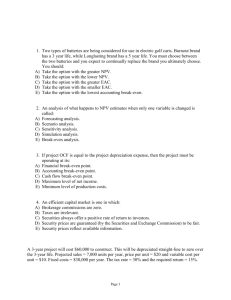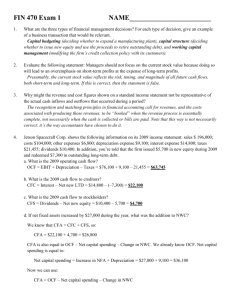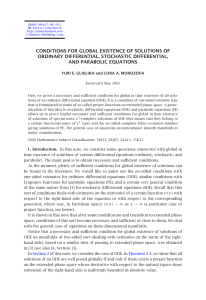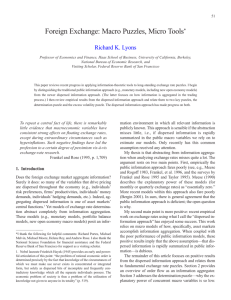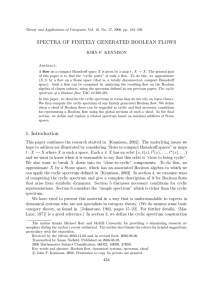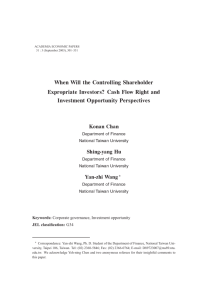App: Equations
advertisement
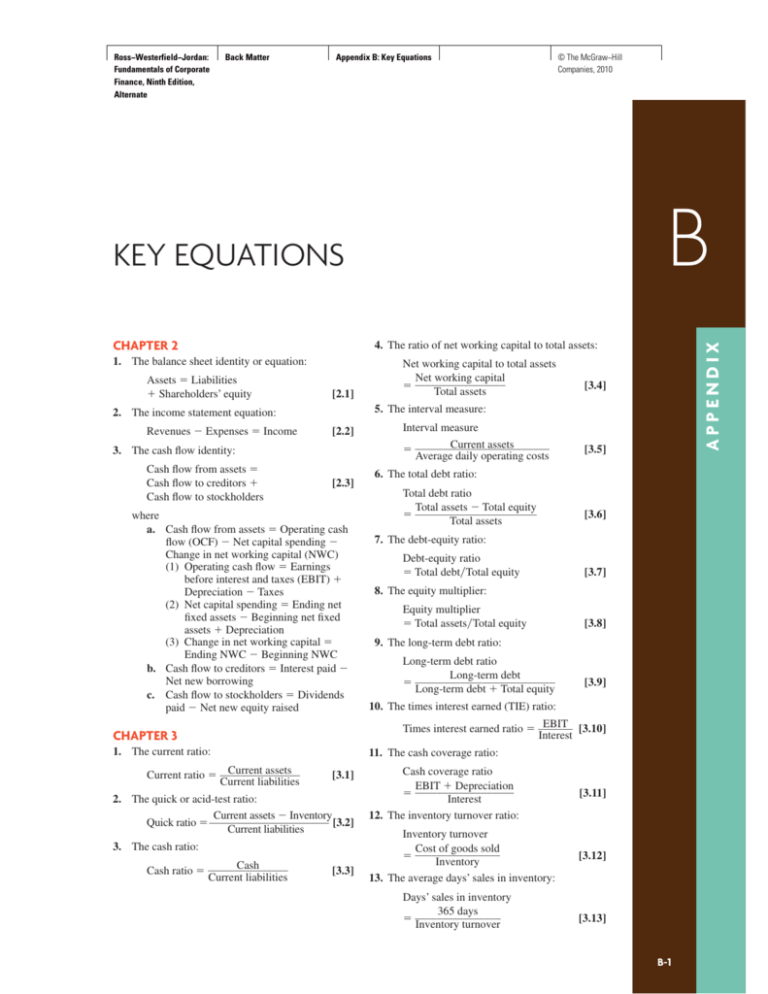
Back Matter
Appendix B: Key Equations
© The McGraw−Hill
Companies, 2010
B
KEY EQUATIONS
CHAPTER 2
4. The ratio of net working capital to total assets:
1. The balance sheet identity or equation:
Assets Liabilities
Shareholders’ equity
[2.1]
[2.2]
3. The cash flow identity:
Cash flow from assets Cash flow to creditors Cash flow to stockholders
[2.3]
where
a. Cash flow from assets Operating cash
flow (OCF) Net capital spending Change in net working capital (NWC)
(1) Operating cash flow Earnings
before interest and taxes (EBIT) Depreciation Taxes
(2) Net capital spending Ending net
fixed assets Beginning net fixed
assets Depreciation
(3) Change in net working capital Ending NWC Beginning NWC
b. Cash flow to creditors Interest paid Net new borrowing
c. Cash flow to stockholders Dividends
paid Net new equity raised
1. The current ratio:
[3.5]
6. The total debt ratio:
Total debt ratio
Total assets Total equity
______________________
Total assets
[3.6]
7. The debt-equity ratio:
Debt-equity ratio
Total debtTotal equity
[3.7]
8. The equity multiplier:
Equity multiplier
Total assetsTotal equity
[3.8]
9. The long-term debt ratio:
Long-term debt ratio
Long-term debt
_________________________
Long-term debt Total equity
[3.9]
10. The times interest earned (TIE) ratio:
11. The cash coverage ratio:
[3.1]
2. The quick or acid-test ratio:
Current assets Inventory
Quick ratio ______________________ [3.2]
Current liabilities
3. The cash ratio:
Cash
Cash ratio _______________
Current liabilities
Interval measure
Current assets
________________________
Average daily operating costs
EBIT [3.10]
Times interest earned ratio _______
Interest
CHAPTER 3
Current assets
Current ratio _______________
Current liabilities
[3.4]
5. The interval measure:
2. The income statement equation:
Revenues Expenses Income
Net working capital to total assets
Net working capital
_________________
Total assets
APPENDIX
Ross−Westerfield−Jordan:
Fundamentals of Corporate
Finance, Ninth Edition,
Alternate
[3.3]
Cash coverage ratio
EBIT Depreciation
__________________
Interest
12. The inventory turnover ratio:
[3.11]
Inventory turnover
Cost of goods sold
________________
Inventory
13. The average days’ sales in inventory:
[3.12]
Days’ sales in inventory
365 days
________________
Inventory turnover
[3.13]
B-1
Ross−Westerfield−Jordan:
Fundamentals of Corporate
Finance, Ninth Edition,
Alternate
B-2
Back Matter
APPENDIX B
© The McGraw−Hill
Companies, 2010
Appendix B: Key Equations
Key Equations
14. The receivables turnover ratio:
Receivables turnover
Sales
_________________
Accounts receivable
15. The days’ sales in receivables:
2. The internal growth rate:
[3.14]
ROA b
Internal growth rate ____________
1 ROA b
[4.2]
3. The sustainable growth rate:
ROE b
Sustainable growth rate ____________
1 ROE b
Days’ sales in receivables
365 days
__________________
Receivables turnover
[3.15]
[3.16]
17. The fixed asset turnover ratio:
Sales
Fixed asset turnover _____________
Net fixed assets
Total assets
Sales
[3.18]
[3.19]
[3.20]
21. Return on equity (ROE):
Net income
Return on equity __________
Total equity
22. The price-earnings (PE) ratio:
Price per share
PE ratio ________________
Earnings per share
PV (1 r)t FVt
PV FVt (1 r)t FVt [1(1 r)t]
Annuity present value
[3.22]
1 Present value factor
C ____________________
r
(
{
[3.23]
[3.24]
Return on assets
t
)
}
[6.1]
2. The future value factor for an annuity:
Annuity FV factor
(Future value factor 1)r
[(1 r)t 1]r
3. Annuity due value Ordinary annuity value
(1 r)
[6.2]
[6.3]
4. Present value for a perpetuity:
ROE Profit margin
Total asset turnover
Equity multiplier
PV for a perpetuity Cr C (1r)
1. The dividend payout ratio:
[4.1]
[6.4]
5. Growing annuity present value
1g t
1 _____
1r
C ___________
rg
[6.5]
6. Growing perpetuity present value
C
_____
rg
[6.6]
CHAPTER 4
Dividend payout ratio
Cash dividendsNet income
[5.3]
1. The present value of an annuity of C dollars per period
for t periods when the rate of return or interest rate is r:
1 [1(1 r) ]
C ______________
r
24. The Du Pont identity:
Sales ______
Net income ______
Assets
ROE __________
Assets
Sales
Equity
[5.2]
3. The relationship between future value and present
value (the basic present value equation):
CHAPTER 6
[3.21]
23. The market-to-book ratio:
Market-to-book ratio
Market value per share
___________________
Book value per share
[5.1]
2. The present value of $1 to be received t periods in
the future at a discount rate of r:
PV $1 [1(1 r)t] $1(1 r)t
20. Return on assets (ROA):
Net income
Return on assets __________
Total assets
1. The future value of $1 invested for t periods at rate
of r per period:
Future value $1 (1 r)t
19. Profit margin:
Net income
Profit margin __________
1
________________
Total asset turnover
CHAPTER 5
[3.17]
18. The total asset turnover ratio:
Sales
Total asset turnover __________
4. The capital intensity ratio:
Total assets
Capital intensity ratio __________
Sales
16. The net working capital (NWC) turnover ratio:
Sales
NWC turnover _____
NWC
[4.3]
(
)
Ross−Westerfield−Jordan:
Fundamentals of Corporate
Finance, Ninth Edition,
Alternate
Back Matter
© The McGraw−Hill
Companies, 2010
Appendix B: Key Equations
APPENDIX B
PV of cash flows
Profitability index ________________
Cost of investment
EAR [1 (Quoted ratem)]m 1
8. Effective annual rate (EAR), where q stands for the
continuously compounded quoted rate:
CHAPTER 10
1. Bottom-up approach to operating cash flow (OCF):
EAR e q 1
OCF Net income Depreciation
CHAPTER 7
[7.1]
[7.2]
[7.3]
[7.4]
[10.3]
[11.1]
2. Relationship between operating cash flow (OCF)
and sales volume:
Q (FC OCF)(P v)
[11.3]
Q FC(P v)
4. Financial break-even level:
[8.3]
Q (FC OCF*)(P v)
where
[8.7]
NPV Present value of future cash flows
Investment cost
2. Payback period:
Payback period Number of years that pass before
the sum of an investment’s cash flows equals the cost
of the investment
3. Discounted payback period:
Discounted payback period Number of years that
pass before the sum of an investment’s discounted
cash flows equals the cost of the investment
IRR Discount rate of required return such that
the net present value of an investment is zero
OCF (Sales Costs) (1 T)
Depreciation T
3. Cash break-even level:
1. Net present value (NPV):
5. Internal rate of return (IRR):
3. Tax shield approach to operating cash flow (OCF):
Q (FC D)(P v)
CHAPTER 9
4. The average accounting return (AAR):
Average net income
AAR _________________
Average book value
[10.2]
1. Accounting break-even level:
2. Required return:
R D1P0 g
OCF Sales Costs Taxes
CHAPTER 11
CHAPTER 8
1. The dividend growth model:
D0 (1 g) ______
D1
P0 ___________
Rg
Rg
[10.1]
2. Top-down approach to operating cash flow (OCF):
1. Bond value if bond has (1) a face value of F paid at
maturity, (2) a coupon of C paid per period, (3) t periods
to maturity, and (4) a yield of r per period:
1 R (1 r) (1 h)
Rrhrh
Rrh
B-3
6. Profitability index:
7. Effective annual rate (EAR), where m is the number
of times the interest is compounded during the year:
Bond value
C [1 1(1 r)t]r F(1 r)t
Bond value
Present value
Present value
of the coupons
of the face amount
2. The Fisher effect:
Key Equations
OCF* Zero NPV cash flow
5. Degree of operating leverage (DOL):
DOL 1 FCOCF
[11.4]
CHAPTER 12
1. Variance of returns, Var(R) or 2:
1 [(R __
R )2 · · ·
Var(R) _____
T 1 __1
(RT R )2]
[12.3]
2. Standard deviation of returns, SD(R) or :
Var(R)
SD(R) CHAPTER 13
1. Risk premium:
Risk premium Expected return
– Risk-free rate
[13.1]
2. Expected return on a portfolio:
E(RP) x1 E(R1) x 2 E(R2) · · ·
xn E(R n)
[13.2]
Ross−Westerfield−Jordan:
Fundamentals of Corporate
Finance, Ninth Edition,
Alternate
B-4
Back Matter
APPENDIX B
Appendix B: Key Equations
© The McGraw−Hill
Companies, 2010
Key Equations
3. The reward-to-risk ratio:
b. Proposition I:
E[Ri] Rf
Reward-to-risk ratio _________
i
VL VU TC D
4. The capital asset pricing model (CAPM):
E(Ri ) Rf [E(RM) Rf ] i
[13.7]
1. Required return on equity, RE (dividend growth model):
[14.1]
2. Required return on equity, RE (CAPM):
RE R f E (RM R f )
[14.2]
3. Required return on preferred stock, RP:
RP DP0
5. Weighted average flotation cost, fA:
fA _E_ fE _D_ fD
V
V
[14.8]
2. The cash cycle:
Cash cycle Operating cycle
Accounts payable period
[18.5]
a. Average daily float:
Total float
Average daily float _________
Total days
b. Average daily float:
Average daily float
Average daily receipts
Weighted average delay
a. Number of new shares:
[19.1]
[19.2]
2. The Baumol-Allais-Tobin (BAT) model:
a. Opportunity costs:
[15.1]
Opportunity costs (C2) R
[19A.1]
b. Trading costs:
Number of rights needed to buy a share of stock
Old shares
[15.2]
__________
New shares
c. Value of a right:
Value of a right Rights-on price Ex-rights
price
Trading costs (TC) F
[19A.2]
c. Total cost:
Total cost Opportunity costs
Trading costs
[19A.3]
d. The optimal initial cash balance:
(2T F)R
C* CHAPTER 16
[19A.4]
3. The Miller-Orr model:
1. Modigliani-Miller propositions (no taxes):
a. The optimal cash balance:
a. Proposition I:
C* L (34 F 2R)13
VL VU
[19A.5]
b. The upper limit:
b. Proposition II:
[16.1]
2. Modigliani-Miller propositions (with taxes):
U* 3 C* 2 L
[19A.6]
CHAPTER 20
a. Value of the interest tax shield:
Present value of the interest tax shield
(TC D RD)RD
TC D
[18.4]
1. Float measurement:
[14.6]
1. Rights offerings:
RE RA (RA RD) (DE )
Operating cycle Inventory period
Accounts receivable period
CHAPTER 19
CHAPTER 15
Number of new shares
Funds to be raised
_______________
Subscription price
b. Number of rights needed:
1. The operating cycle:
[14.3]
4. The weighted average cost of capital (WACC):
WACC (EV) RE (DV) RD
(1 TC)
[16.4]
CHAPTER 18
CHAPTER 14
RE D1P0 g
c. Proposition II:
RE RU (RU RD) (DE )
(1 TC)
[16.3]
1. The size of receivables:
[16.2]
Accounts receivable
Average daily sales ACP
[20.1]
Ross−Westerfield−Jordan:
Fundamentals of Corporate
Finance, Ninth Edition,
Alternate
Back Matter
© The McGraw−Hill
Companies, 2010
Appendix B: Key Equations
APPENDIX B
3. Uncovered interest parity (UIP):
2. NPV of switching credit terms:
E(St) S0 [1 (RFC RUS)]t
a. Present value of switching:
PV [(P v)(Q Q)]R
[20.4]
[20.5]
c. NPV of switching:
NPV of switching [PQ v(Q Q)]
[(P v)
(Q Q)]R
[20.6]
[20.9]
[20.10]
[24.5]
[24.6]
1. Put-call parity condition:
C S N(d1) E eRt N(d2)
[20.12]
[25.2]
[20.15]
[21.4]
b. Approximate, multiperiod:
[21.7]
[25.7]
CHAPTER 26
4. The NPV of a merger:
NPV V *B Cost to Firm A of
the acquisition
a. Exact, single period:
[25.6]
3. Value of a risk-free bond:
Value of risky bond Put option
[21.3]
[25.5]
where
d1 [ln(SE) (R 22) t]( t )
d2 d1 t
2. Interest rate parity (IRP):
Ft S0 [1 (RFC RUS)]t
[24.4]
2. The Black-Scholes call option formula:
1. Purchasing power parity (PPP):
F1S0 (1 RFC)(1 RUS)
Stock value
Present value of the exercise price
C0 S0 E(1 Rf )t
S P PV(E) C
CHAPTER 21
E(St) S0 [1 (hFC hUS)]t
b. Lower bound:
C0 0 if S0 E 0
C0 S0 E if S0 E 0
[24.3]
CHAPTER 25
[20.11]
d. The optimal order size Q*:
2T F
C0 S0
C0 S0 E(1 R f )
c. Total costs:
CC
_______
[24.2]
4. Value of a call that is certain to finish in-the-money:
Call option value
b. Total restocking costs:
Q* b. C1 S1 E if (S1 E) 0
3. S0 C0 E(1 R f )
a. Total carrying costs:
Total costs Carrying costs
Restocking costs
(Q2) CC
F (TQ)
[24.1]
[20.8]
4. The economic order quantity (EOQ) model:
Total restocking costs
Fixed cost per order
Number of orders F (TQ)
a. C1 0 if (S1 E) 0
a. Upper bound:
b. With repeat business:
Total carrying costs
Average inventory
Carrying costs per unit
(Q2) CC
CHAPTER 24
2. Bounds on the value of a call option:
a. With no repeat business:
NPV v (1 )(P v)R
[21.10]
1. Value of a call option at maturity:
3. NPV of granting credit:
NPV v (1 )P(1 R)
[21.9]
4. International Fisher effect (IFE):
RUS hUS RFC hFC
b. Cost of switching:
Cost of switching PQ v(Q Q)
B-5
Key Equations
[26.1]
